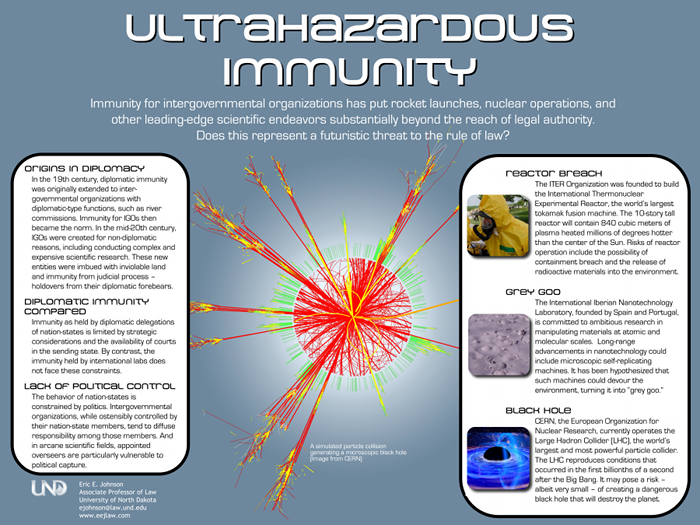Ultrahazardous Immunity poster
presented at 10th Annual Graduate School Scholarly Forum, University of North Dakota, Grand Forks, March 2011
Text and graphic design by Eric E. Johnson. Illustation by CERN. Inset images, top to bottom, by Fred W. Baker III for DOD, Harlan Kredit for NPS, Jörn Wilms for ESA/NASA.
The text of the poster:
Ultrahazardous Immunity
Immunity for intergovernmental organizations has put rocket launches, nuclear operations, and other leading-edge scientific endeavors substantially beyond the reach of legal authority. �Does this represent a futuristic threat to the rule of law?
Origins in Diplomacy
In the 19th century, diplomatic immunity was originally extended to inter-governmental organizations with diplomatic-type functions, such as river commissions. Immunity for IGOs then became the norm. In the mid-20th century, IGOs were created for non-diplomatic reasons, including conducting complex and expensive scientific research. These new entities were imbued with inviolable land and immunity from judicial process – holdovers from their diplomatic forebears.
Diplomatic Immunity Compared
Immunity as held by diplomatic delegations of nation-states is limited by strategic considerations and the availability of courts in the sending state. By contrast, the immunity held by international labs does not face these constraints.
Lack of Political Control
The behavior of nation-states is constrained by politics. Intergovernmental organizations, while ostensibly controlled by their nation-state members, tend to diffuse responsibility among those members. And in arcane scientific fields, appointed overseers are particularly vulnerable to political capture.
Reactor Breach
The ITER Organization was founded to build the International Thermonuclear Experimental Reactor, the world’s largest tokamak fusion machine. The 10-story tall reactor will contain 840 cubic meters of plasma heated millions of degrees hotter than the center of the Sun. Risks of reactor operation include the possibility of containment breach and the release of radioactive materials into the environment.
Grey Goo
The International Iberian Nanotechnology Laboratory, founded by Spain and Portugal, is committed to ambitious research in manipulating materials at atomic and molecular scales. Long-range advancements in nanotechnology could include microscopic self-replicating machines. It has been hypothesized that such machines could devour the environment, turning it into “grey goo.”
Black Hole
CERN, the European Organization for Nuclear Research, currently operates the Large Hadron Collider (LHC), the world’s largest and most powerful particle collider. The LHC reproduces conditions that occurred in the first billionths of a second after the Big Bang. It may pose a risk – albeit very small – of creating a dangerous black hole that will destroy the planet.
A simulated particle collision generating a microscopic black hole
(Image from CERN)
Eric E. Johnson
Associate Professor of Law
University of North Dakota
ejohnson@law.und.edu
www.eejlaw.com
Copyright 2011 Eric E. Johnson. All rights reserved. Konomark: Most rights sharable.


